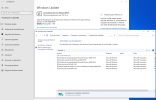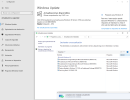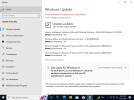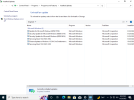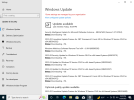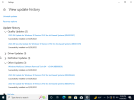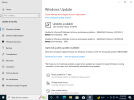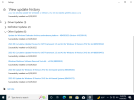D
You are using an out of date browser. It may not display this or other websites correctly.
You should upgrade or use an alternative browser.
You should upgrade or use an alternative browser.
Problem with KB5016616 (Windows 10 21H2)
- Thread starter Deleted member 9735
- Start date
-
- Tags
- windows 10 21h1
This is the same question you asked once, and the answer's unchanged.
WU doesn't check by KB versions, it scans all installed WinSxS components and if any of them are not up-to-date it will download the latest CU which includes the newer components.
WU won't reinstall the entire CU, just the marked components. But it cannot download partial files, so it must get the entire package.
How do you avoid this? Check if you're installing language updates or other updates AFTER CU gets applied. The best way is doing two passes: 1. Integrate any extra language features, and apply. 2. Integrate CU + .NET updates and do the rest of modding. Don't use Dynamic Update because it forces WU to check and refresh the install in ways you can't predict.
WU doesn't check by KB versions, it scans all installed WinSxS components and if any of them are not up-to-date it will download the latest CU which includes the newer components.
WU won't reinstall the entire CU, just the marked components. But it cannot download partial files, so it must get the entire package.
How do you avoid this? Check if you're installing language updates or other updates AFTER CU gets applied. The best way is doing two passes: 1. Integrate any extra language features, and apply. 2. Integrate CU + .NET updates and do the rest of modding. Don't use Dynamic Update because it forces WU to check and refresh the install in ways you can't predict.
D
Deleted member 9735
Guest
The same question because this bug is repeated over and over again in each version and I must report it (or not?)
Everything you say I already did. The problem persists. I only integrate the cumulative update KB5016616 and the net framework cumulative update to the ISO (no preview, no drivers, nothing else)
Everything you say I already did. The problem persists. I only integrate the cumulative update KB5016616 and the net framework cumulative update to the ISO (no preview, no drivers, nothing else)
Last edited by a moderator:
Hellbovine
Well-Known Member
I think Necrosaro is onto something there, and you should give what he said a shot. It plays into my thoughts as well:
My post here isn't meant to be a bash on Microsoft, rather something else for alejcbox to consider, since I think these two threads have petered out now.
It could just be a bug. Windows Update has been notorious for this kind of quirk for many years. Even on an official, untweaked W10 install, Windows Update (through Windows settings page, not NTLite) tries to install 3 incorrect chipset drivers on my machine. It also gave me huge problems with my printer, so much that I went out and just bought a new printer as a workaround because the other one was old and I just didn't want to deal with it.
This is why I don't ever use Windows Update anymore (apart from troubleshooting purposes), and haven't since the XP days. The exceptions I made were to download Service Packs only, which I think died out as a concept with Windows 7, and so then from that point I stuck with just the yearly ISO updates and treated that as my cumulative update packs. I reinstall cleanly every 6-12 months depending on if the ISO release is worth "upgrading" to (for my friends/family anyway, I personally stuck with XP until 2021 on my gaming computer). There's really no need for anyone to be on the bleeding edge of Windows Updates.
Check out some internet articles regarding Windows 10 updates being problematic (they had a lot of them throughout W10's lifespan so far):
(https://www.forbes.com/sites/gordon...d-for-millions-of-microsoft-windows-10-users/)
(https://www.extremetech.com/computing/320757-new-windows-10-update-is-causing-blue-screen-crashes)
Anyway, I know it sucks not being able to find a satisfactory resolution for something, but just keep in mind the problem more often than not is Windows. Maybe it would be helpful to put in a support ticket at Microsoft regarding this update and see what they say.
Also, check out the known issues list for this KB update in question, the known issues it introduces are literally longer than the list of stuff it fixes!
(https://support.microsoft.com/en-us...044-1889-67412989-3b5f-4443-89b4-f743382ab970)
The known issues list has information on how to slipstream this update too, if nobody took a look at that already.
My post here isn't meant to be a bash on Microsoft, rather something else for alejcbox to consider, since I think these two threads have petered out now.
It could just be a bug. Windows Update has been notorious for this kind of quirk for many years. Even on an official, untweaked W10 install, Windows Update (through Windows settings page, not NTLite) tries to install 3 incorrect chipset drivers on my machine. It also gave me huge problems with my printer, so much that I went out and just bought a new printer as a workaround because the other one was old and I just didn't want to deal with it.
This is why I don't ever use Windows Update anymore (apart from troubleshooting purposes), and haven't since the XP days. The exceptions I made were to download Service Packs only, which I think died out as a concept with Windows 7, and so then from that point I stuck with just the yearly ISO updates and treated that as my cumulative update packs. I reinstall cleanly every 6-12 months depending on if the ISO release is worth "upgrading" to (for my friends/family anyway, I personally stuck with XP until 2021 on my gaming computer). There's really no need for anyone to be on the bleeding edge of Windows Updates.
Check out some internet articles regarding Windows 10 updates being problematic (they had a lot of them throughout W10's lifespan so far):
(https://www.forbes.com/sites/gordon...d-for-millions-of-microsoft-windows-10-users/)
(https://www.extremetech.com/computing/320757-new-windows-10-update-is-causing-blue-screen-crashes)
Anyway, I know it sucks not being able to find a satisfactory resolution for something, but just keep in mind the problem more often than not is Windows. Maybe it would be helpful to put in a support ticket at Microsoft regarding this update and see what they say.
Also, check out the known issues list for this KB update in question, the known issues it introduces are literally longer than the list of stuff it fixes!
(https://support.microsoft.com/en-us...044-1889-67412989-3b5f-4443-89b4-f743382ab970)
The known issues list has information on how to slipstream this update too, if nobody took a look at that already.
Last edited:
Hellbovine
Well-Known Member
Also, this is worth asking on every post like this. What is the concept behind using outdated versions of Windows and then integrating them with the latest Windows Updates? You're defeating the point of whatever reason you chose to stick with the older version for.
I.E. You have Windows 10 21H1, while 21H2 is the latest supported version. If Windows Updates are a concern, then why stick with 21H1? Have you considered using 21H2 as your base image instead?
I.E. You have Windows 10 21H1, while 21H2 is the latest supported version. If Windows Updates are a concern, then why stick with 21H1? Have you considered using 21H2 as your base image instead?
Last edited:
D
Deleted member 9735
Guest
windows 10 pro x64 original 21h2Also, this is worth asking on every post like this. What is the concept behind using outdated versions of Windows and then integrating them with the latest Windows Updates? You're defeating the point of whatever reason you chose to stick with the older version for.
I.E. You have Windows 10 21H1, while 21H2 is the latest supported version. If Windows Updates are a concern, then why stick with 21H1? Have you considered using 21H2 as your base image instead?
D
Deleted member 9735
Guest
Maybe you should take a look at the images I posted at the beginning of this thread.New install of 21H2 Aug 2022 (no removals or tweaks). My question like last time, what's different in the two setups?
Integrated updates:
RTM + KB5012170, KB5015730, KB5016616
What I did was::
1. Download the original ISO 21h2
2. Integrate only the KB5016616 update (no removals or tweaks)
3. Install the ISO on a computer or VM and run windows update
And the result was the one I published in the images.
where you can see that windows update downloads KB5016616 again despite being previously integrated with ntlite.
I have no other way to explain it. I have only tested on windows 10 pro x64 21h2. I don't know if the same will happen in other versions.
RTM + KB5016616
Unmodified except for autounattend, and disabled WU auto-install.
1. Installed on VMware Workstation.
2. Ran WU to check for downloads. WU installed .NET + non-CU updates.
3. Rebooted. WU updated Defender.
Once more: you're able to recreate this problem, I can't. So what's the hidden details in this problem?
Unmodified except for autounattend, and disabled WU auto-install.
1. Installed on VMware Workstation.
2. Ran WU to check for downloads. WU installed .NET + non-CU updates.
3. Rebooted. WU updated Defender.
Once more: you're able to recreate this problem, I can't. So what's the hidden details in this problem?
Attachments
Kasual
Well-Known Member
I can see 2 SSU integrated and other updates (the source have "pending installs" I know, but all of them are built in except KB5016616?)Maybe you should take a look at the images I posted at the beginning of this thread.
What I did was::
1. Download the original ISO 21h2
2. Integrate only the KB5016616 update (no removals or tweaks)
3. Install the ISO on a computer or VM and run windows update
is the image saved in the drive or have you extracted from an unmodified ISO to only do the tests?
D
Deleted member 9735
Guest
This thread is no longer needed because it was released September 13, 2022—KB5017308 (OS Builds 19042.2006, 19043.2006, and 19044.2006). Thanks

